Cooking with pine pollen or cattail pollen is fascinating. If you've been wondering how to get your own, and what to do with it, I explain all of that in this post.
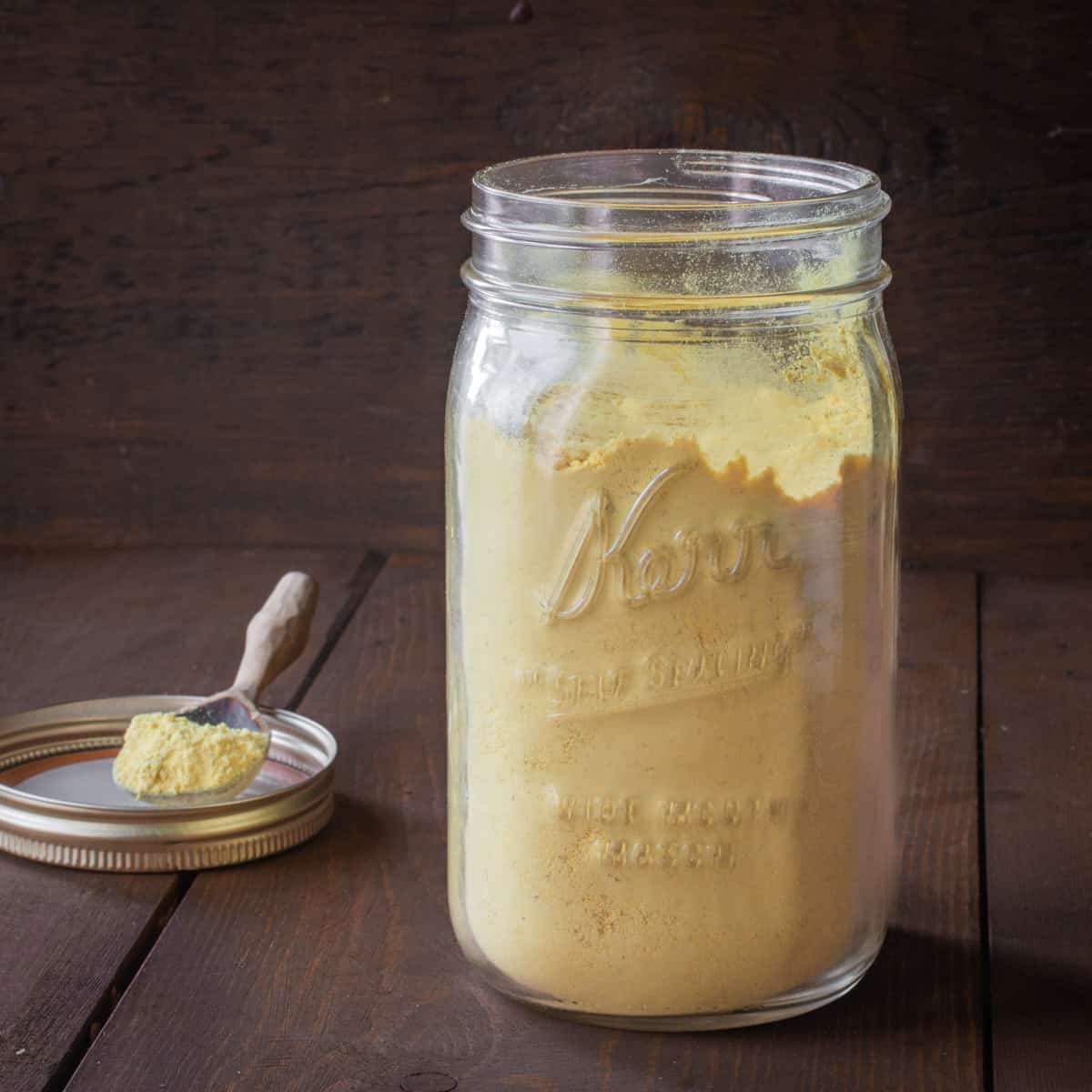
Most foragers know of cattail pollen, but, if you live in a city, finding marshes where you can harvest, getting waterproof clothing/waders, and, most importantly, hitting the spot at the correct time when the pollen is ready can turn harvesting an interesting ingredient into a frustrating experiment, at least it did for me at first.
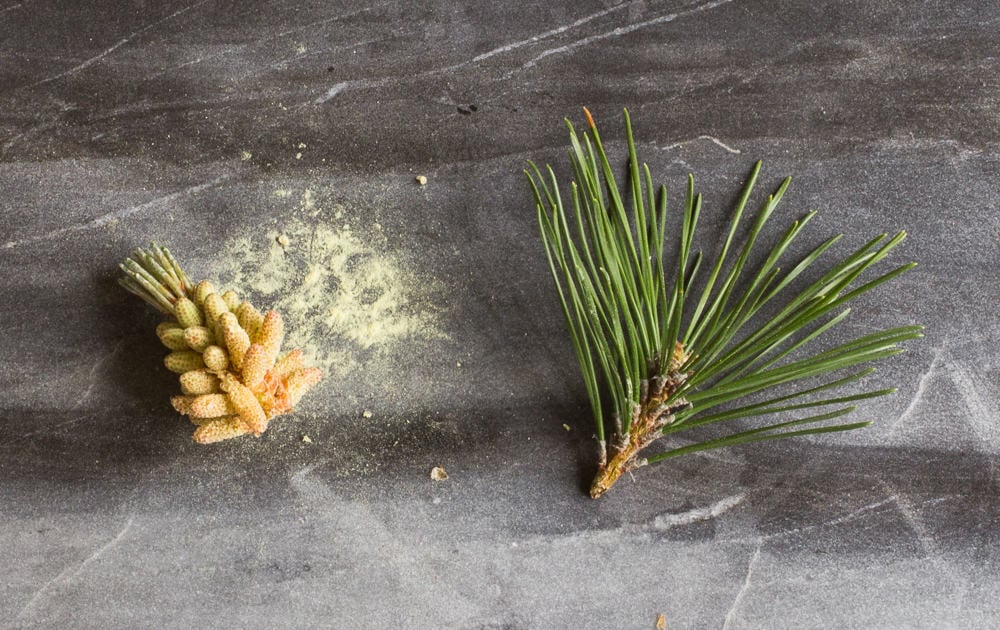
I'm embellishing here, but, it's likely your cattail pollen-harvesting adventure might yield a few tablespoons of yellow fluff, filled with ants and swamp detritus. Then after processing, you might look online, and see recipe that call for cups of pollen at a time, and, if you're like me, wonder how the hell someone could harvest that much, hurl your pitifully tiny bowl of pollen in the air and swear to never try harvesting it again.
After years of honing my skill and practicing, I can tell you that harvesting good amounts of pine pollen is possible, but it is tricky. The trees, at least near me, seem to have about one day, maybe two if the wind is light where the pollen is peaking.
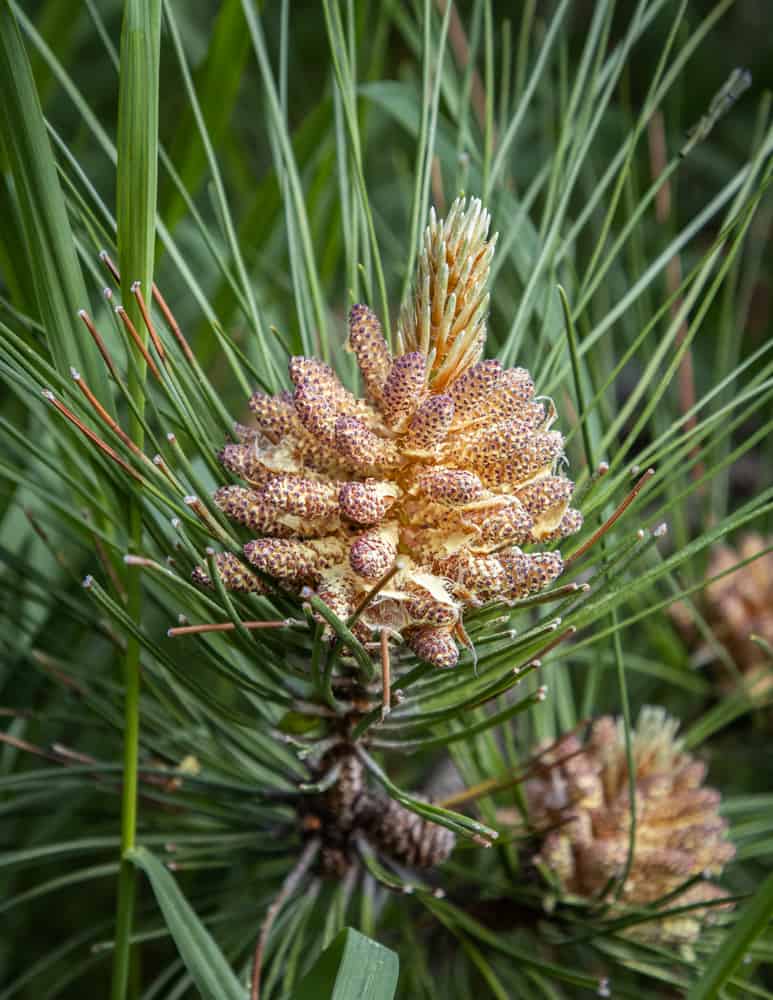
Cattail pollen isn't that tough to get, I've done it, and made pancakes and muffins. But, the timing can be difficult, and I find pine pollen a little more forgiving. You also get to walk on dry land. But, I'm getting ahead of myself. First, you probably want to know why on earth anyone would want to harvest the stuff.
Why harvest pine pollen?
I like to cook with interesting ingredients, and pine pollen is fascinating, delicious, and not available in any store (at least that I'm aware of, there are some Asian companies that sell it online but it's often bitter and foul tasting). For some, pine pollen, and other pollens, like cattail, are used in medicinal ways, or taken as supplements as the pollen contains testosterone. Pine pollen especially, has been used in Asia as a medicine for a long time, like *a lot* of things.
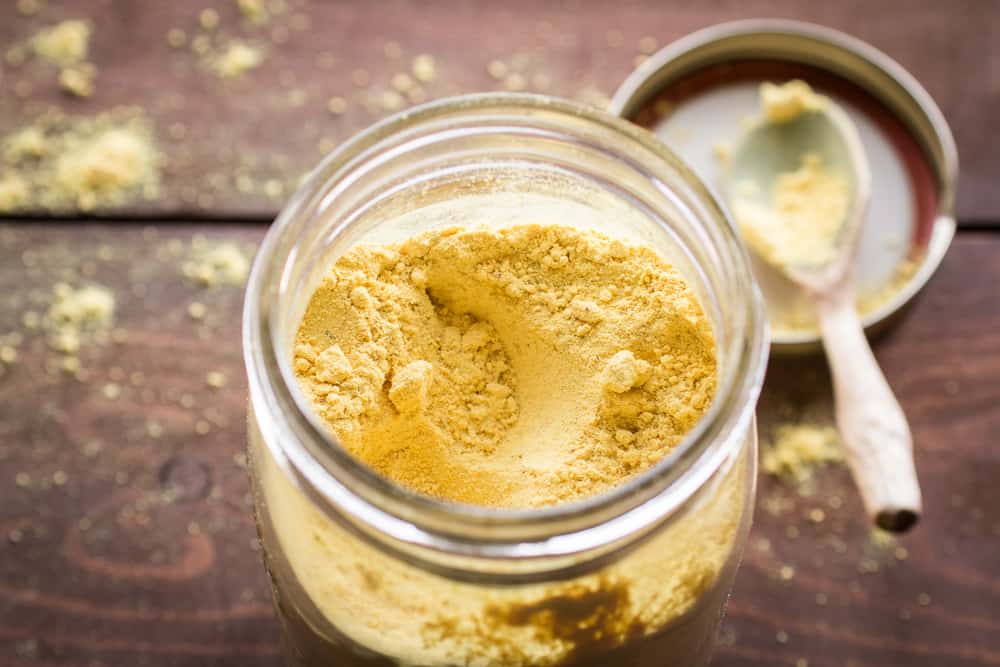
It's a nutritious substance, but like other "medicinal" items, I think its a good idea to research it before putting inside your body, especially if you're pregnant. It goes without saying too, if you have bad pollen allergies, cooking with pollen probably won't be for you. If you're looking for medicinal tips and tricks, you won't find any here, but, I can definitely tell you how to harvest it and get the best yield, store it, and share how I cook with it.
Flavor
Taste a fingertip of pollen and, if you're like me, you're not going to be too impressed. Appearances and tastes can be deceiving though, and pollen absolutely has a flavor, and it's one of the most interesting ingredients I've ever cooked with. The taste is mild, pleasant, and, almost a bit cheesy and yeasty. It's not unpleasant. There's also the texture. Pollen has a sort of not-unpleasant granular quality to it that you'll be able to pick out eventually in things that you make, it's a special quality, and part of what makes it special.
Harvesting
The hardest part is getting to the trees before the wind has done it's job to carry the pollen away. Where I live in Minnesota, this is usually around the third or fourth week of May. Here's what I do: I go to a place that has lots of pine trees, in my area, typically red pine, and I look for male pine flowers yellow and plump, absolutely bursting with pollen.
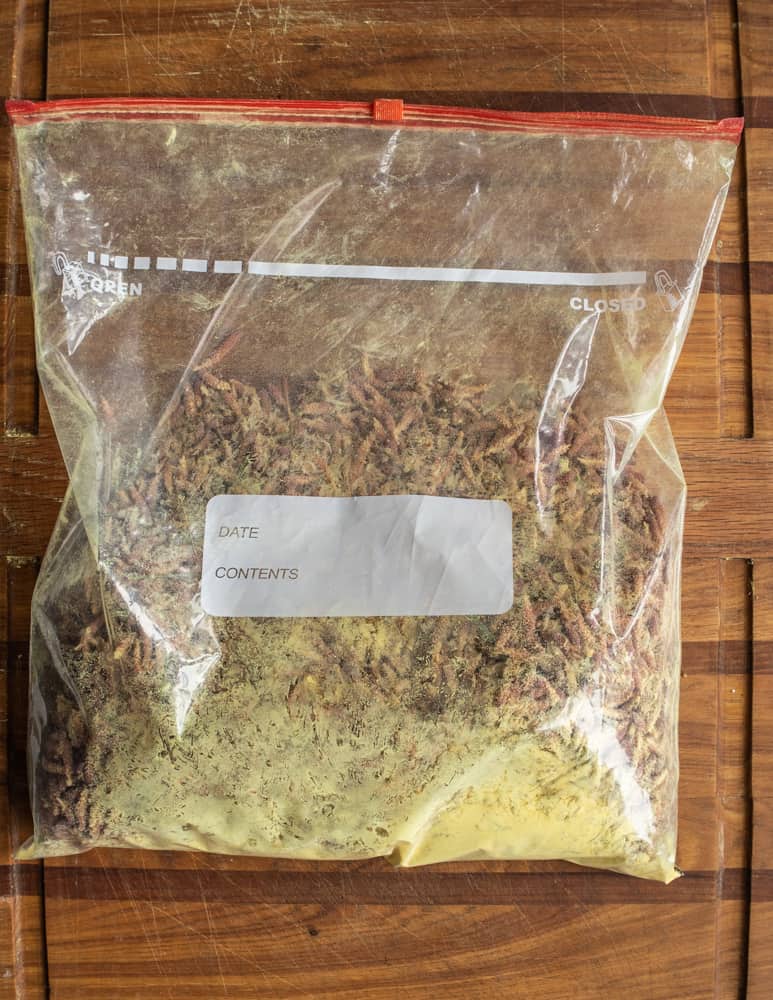
I bring with two-gallon sized zip-loc bags, walk up to the tree, gingerly put the pine flowers into the bag, shake them and agitate the flowers. Unlike cattail pollen, It's going to be difficult to use the old gallon milk jug with a hole cut out that you place over the branches and shake off the pollen, so, my advice is to try it out, and figure out what works for you. The jumbo zip-loc bags, being see-through, allow you to gauge how much pollen you're getting quickly though, so I definitely recommend them.
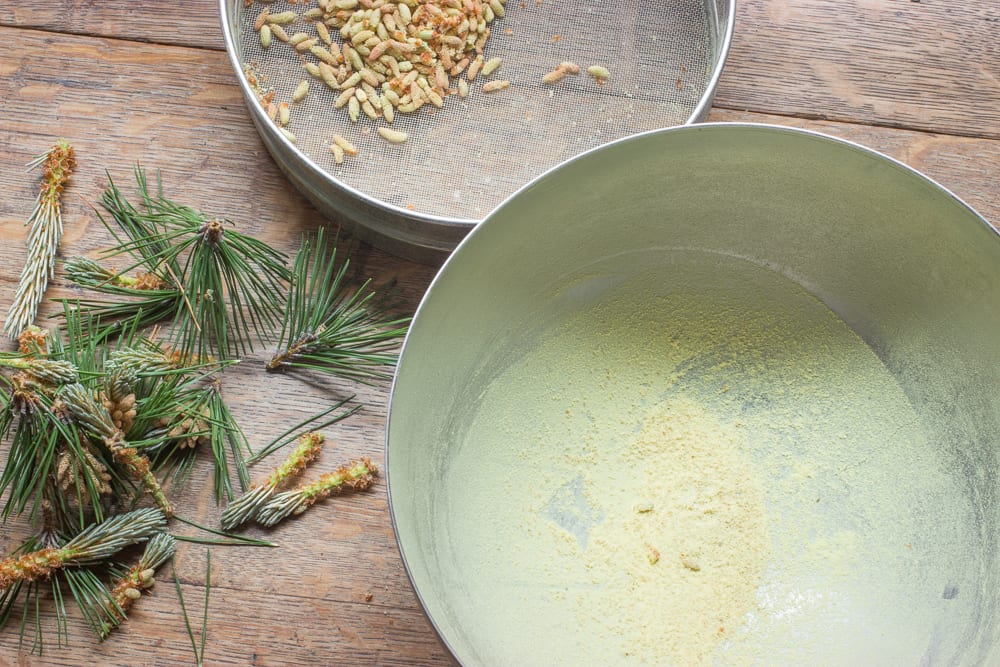
Yield
My current record for pine pollen is 4 cups of finished, double-sifted pollen in 1.5 hours. Previously my record was 2 cups in an afternoon. See my tips for success below to maximize your efficiency.
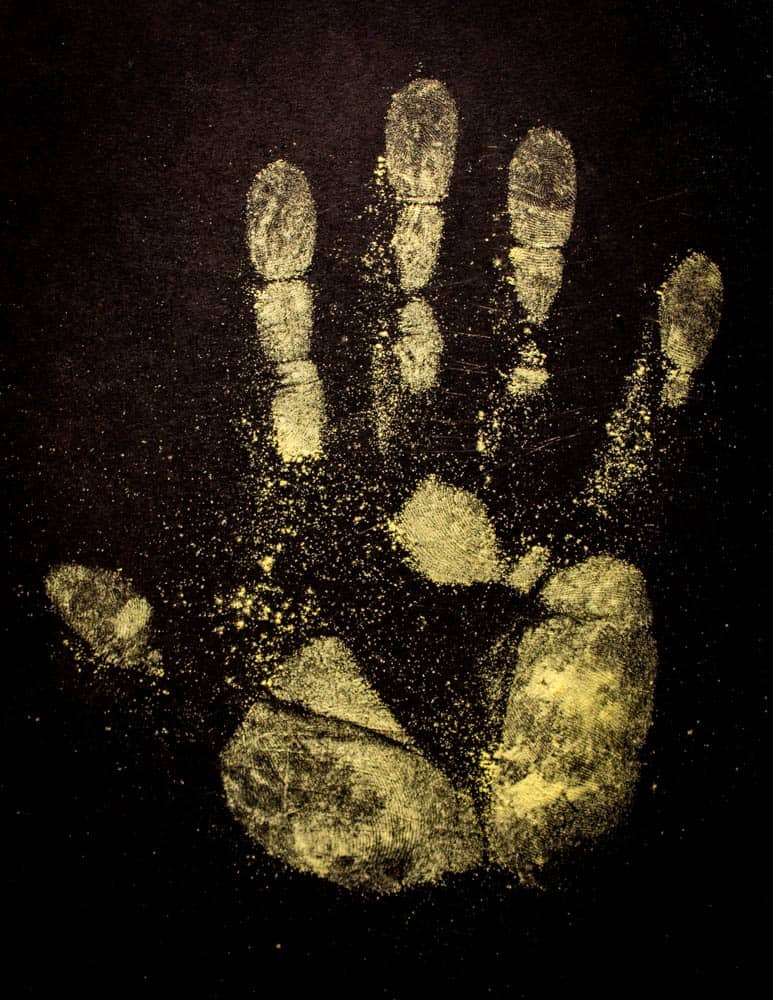
Tips for success
Read this. After years of honing my skills, I have some great tips for you.
- Just a little puff of pollen isn't enough to warrant dedicating an afternoon of your time accosting trees for their genetic material. You want male cones absolutely bursting, dripping with pollen.
The wind is your enemy
- I used to harvest pine pollen from a grove of red pine on the top of a hill. It's a windy hill, and not ideal. For maximum pollen, you want trees at their peak of production, preferably in a place that has a windbreak around it. Now I go to my grandfathers house, where, right behind his shop, there's a grove of trees protected from heavy wind. I harvested over 4 times the amount of pollen in one outing there the first time I went.
- You want trees with low-hanging branches you can reach. Also, don't overlook branches that dip low into the grass, as they can be more protected from the wind.
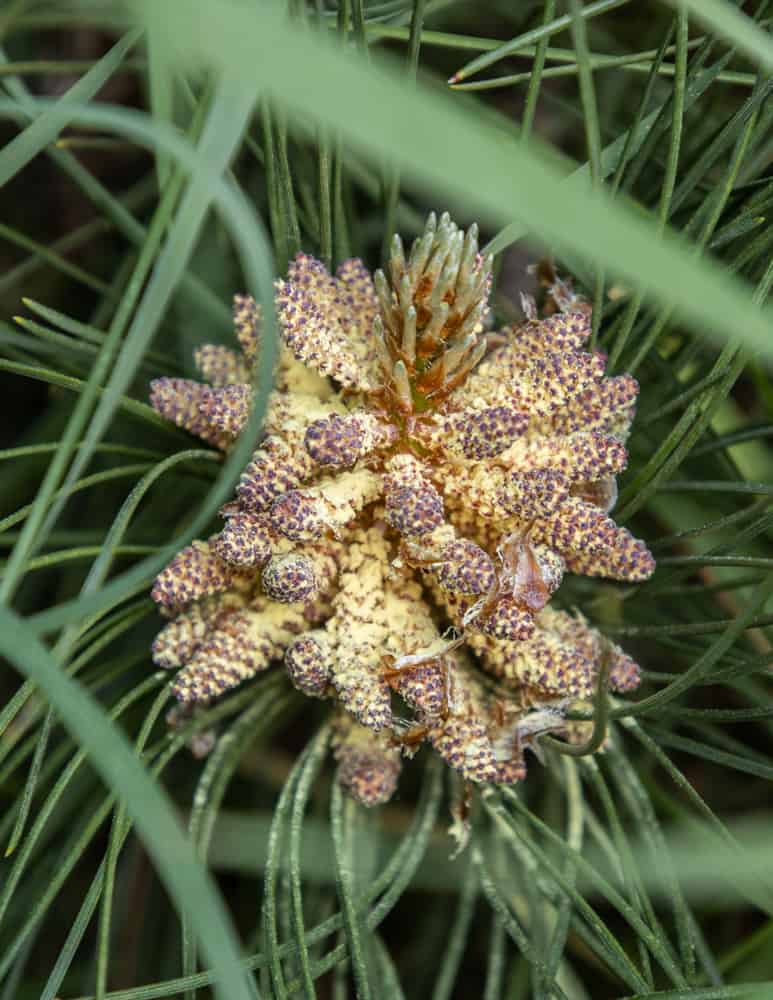
Consider wearing a mask

When you get a good tree at peak pollen production, the amount of pollen that comes from the branches should shock and amaze you. That being said, breathing in large amounts of pollen is probably not great for you, and wearing a mask or some other kind of face covering might be in order.
Don't crush the catkins
I've seen a number of different ways to do this online, and some other ones will work, but don't crush the catkins up in something like a mortar and pestle, or worse, a food processor. Crushing, or using other violent force to break up the catkins will only give you a less pure result, and a diluted color with flecks of red catkin material. You want pollen, as pure as possible, not catkin fibers mixed with pollen.
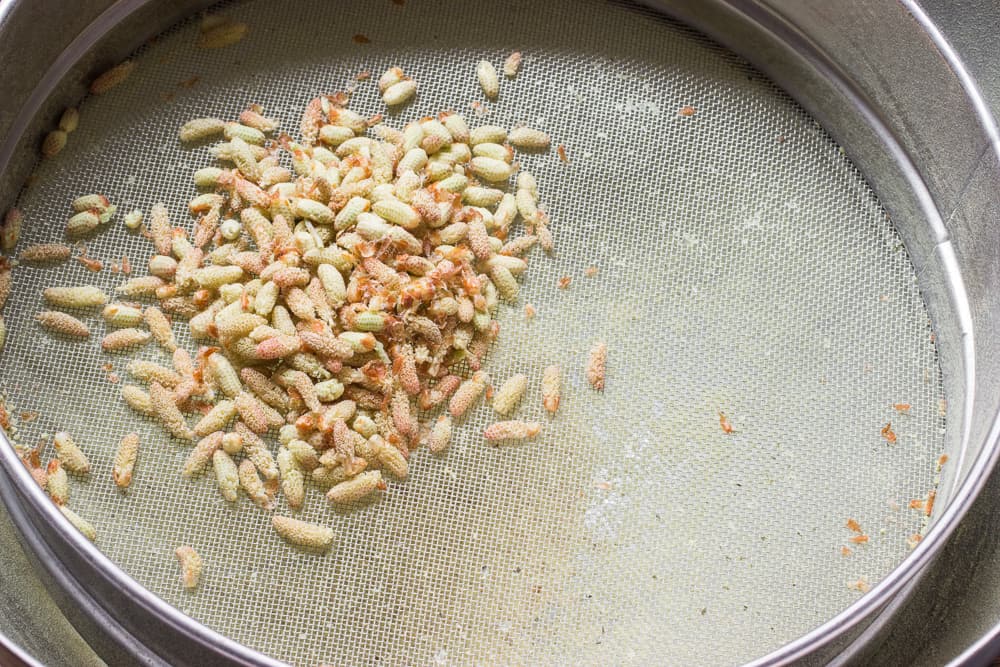
Sift that pollen-twice
After you've sifted your pollen once, it's a good idea to sift it again, just to get it as pure as possible. You'll probably notice a lot of things in your pollen as you do the first sift: pine needles, various tree debris, and, live ants, weevels, spiders, etc. You are not the only one attracted to pollen.
Storing (freeze it)
This is important. Think of pine pollen as a living thing, with compounds (especially delicate, flavorful ones) that need to be cared for. Just like a lot of other products, like flower infusions and the like, keeping the pollen refrigerated or preferably frozen to prevent it going rancid is the best way to store it in my experience.
I keep my pollen in a glass jar in a freezer, and a back up in a vacuum sealed bag inside another bag. You could sure put it in a glass jar too, especially if you want to dip into it regularly, but remember that the more air in the container, the more chance of off-aromas getting into your haul.
"Keeping the pollen frozen to prevent it going rancid is the best way to store it in my experience."
Cooking
Cooking with pollen is interesting. It has a delicate flavor, and adds an interesting texture to baked goods. Older anthropological accounts have claimed that things made with pollen have a "biscuit-y" quality to them, which is a bit hard to parse, but it is true, it's an almost cheesy, yeasty quality, but you won't notice it unless you cook with decent amounts (roughly 25 % of the flour in baked goods) adding a couple spoonfuls of pollen to pancakes is a waste of pollen. Depending on the preparation and how much pollen you use in cooking, the flavor of the pollen can be assertive and at the forefront, or more of a supportive background flavor. Here's some tips I've learned from years of cooking with it.
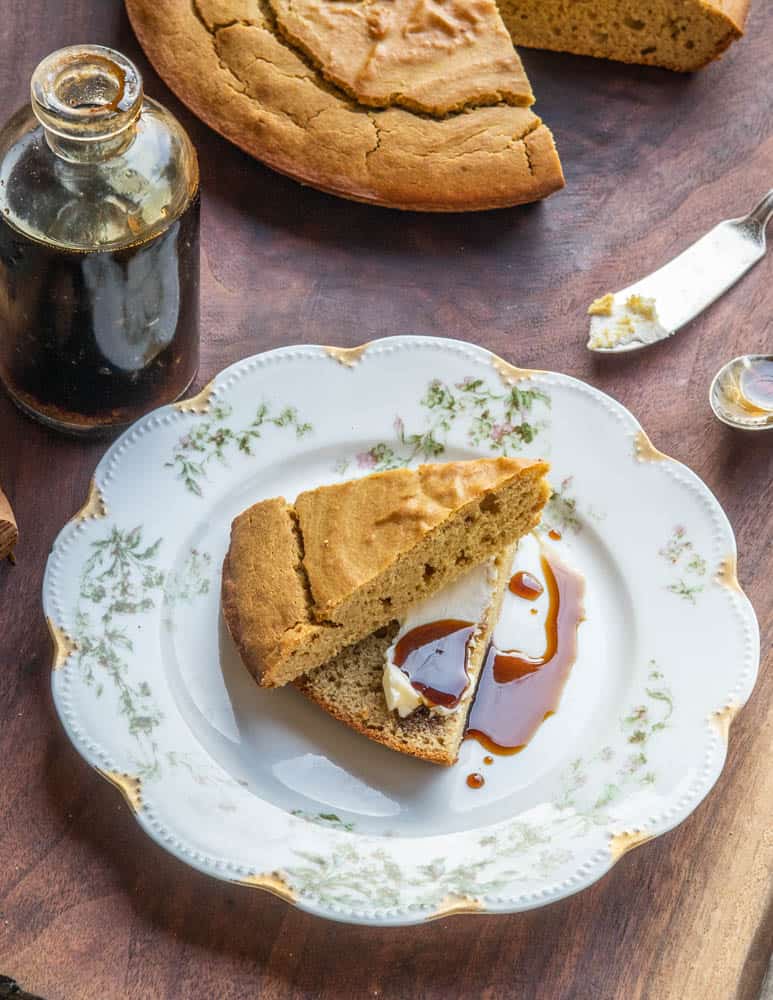
Pollen=More texture than flavor, sometimes
Pine pollen has a mild flavor, and if you use it in something like pancakes or cookies, you're going to notice more of a subtle yellow color and gentle texture it adds than you will a defined pollen flavor. For a pronounced pollen flavor, you'll want to try my pine pollen fudge, inspired by a similar confection made both in Iraq and China.
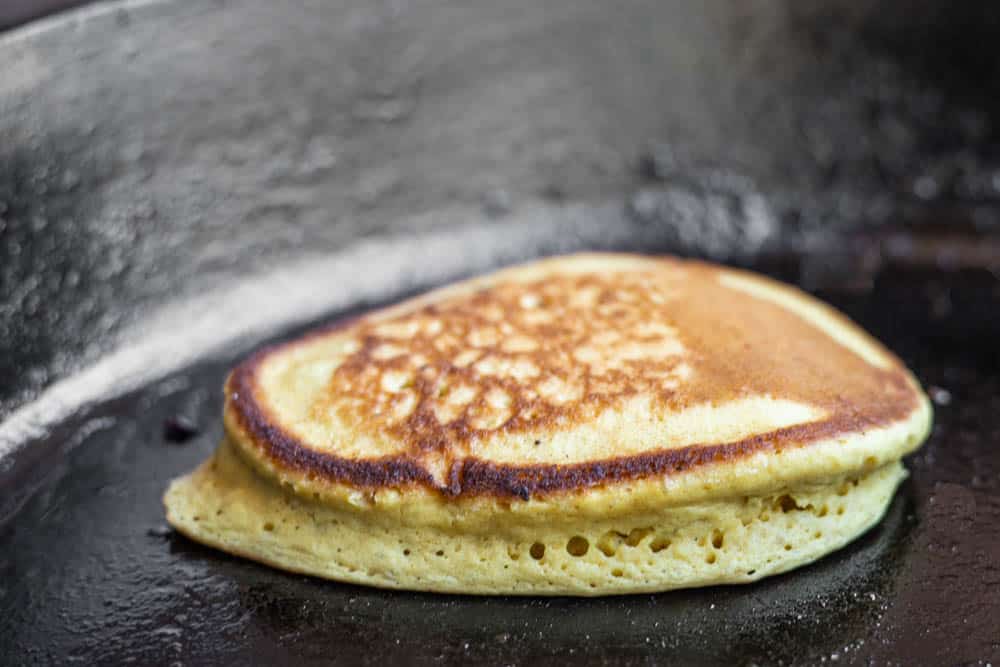
Traditional recipes
Pollen has been used traditionally around the world for a very long time, typically cattail pollen is used, but pine pollen is very similar, near identical for basic culinary purposes besides a minute difference in flavor, so the two pollens can be interchanged. Mostly around the world, I've read of pollen being used as the chief ingredient in a few different sweets.
Pollen "fudge/truffles"
"In southern Iraq and China, the pollen is mixed with honey and sold as a sweetmeat" (From Plant Portraits, link at bottom of the page)
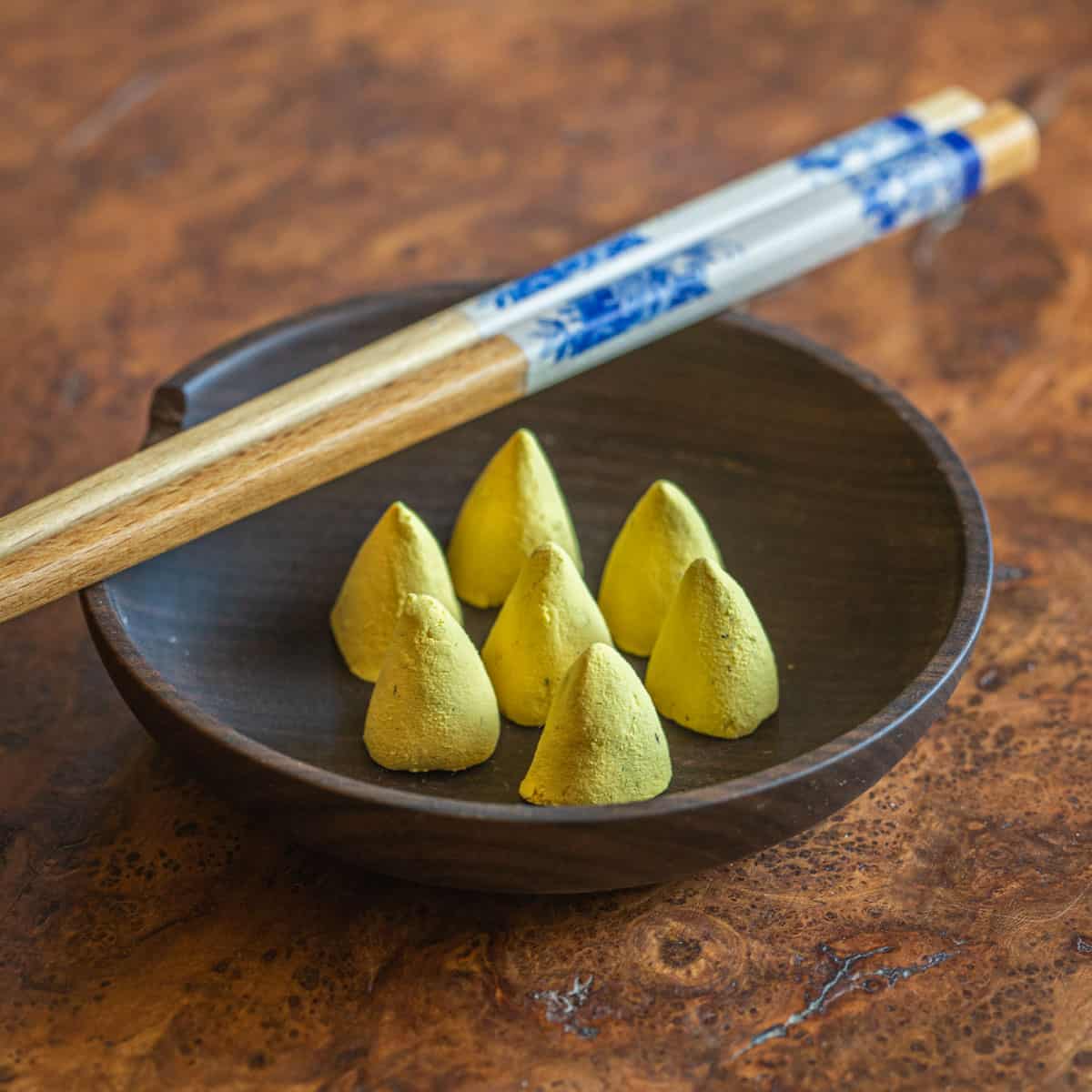
I had to try and recreate the sweet made in China, and finding resources was difficult, but I eventually found it. The sweets are a traditional Chinese treat eaten in the Spring, and are made with nothing more than pine pollen and honey. I came up with a variation that's easy to make at home that incorporates a little butter to help it stick together. You mix a little butter and honey with pollen, mix it together until it forms a mass, then use three fingers to form the mixture into small cones, which are the traditional shape eaten with chopsticks. See the video below for a demo.
Use in baking (25% pollen 75% flour)
One of the most accessible ways to use pollen is to simply add it to baked goods with flour. Sweet quick breads and things like pancakes and cornbread can be very good with pollen in them, but know this: it will not do to simply toss a spoonful or two of pollen into some pancake mix. After years of cooking with different types of pollen, I've found that using about 25% pollen to the total amount of flour in a recipe works well.
Some clarity is useful here though. Since pollen contains no gluten, and doesn't absorb water in the same ratio as flour, I do not substitute 25% of the flour for pollen, rather, I add 25% of the amount of flour in pollen, along with the regular amount of flour.
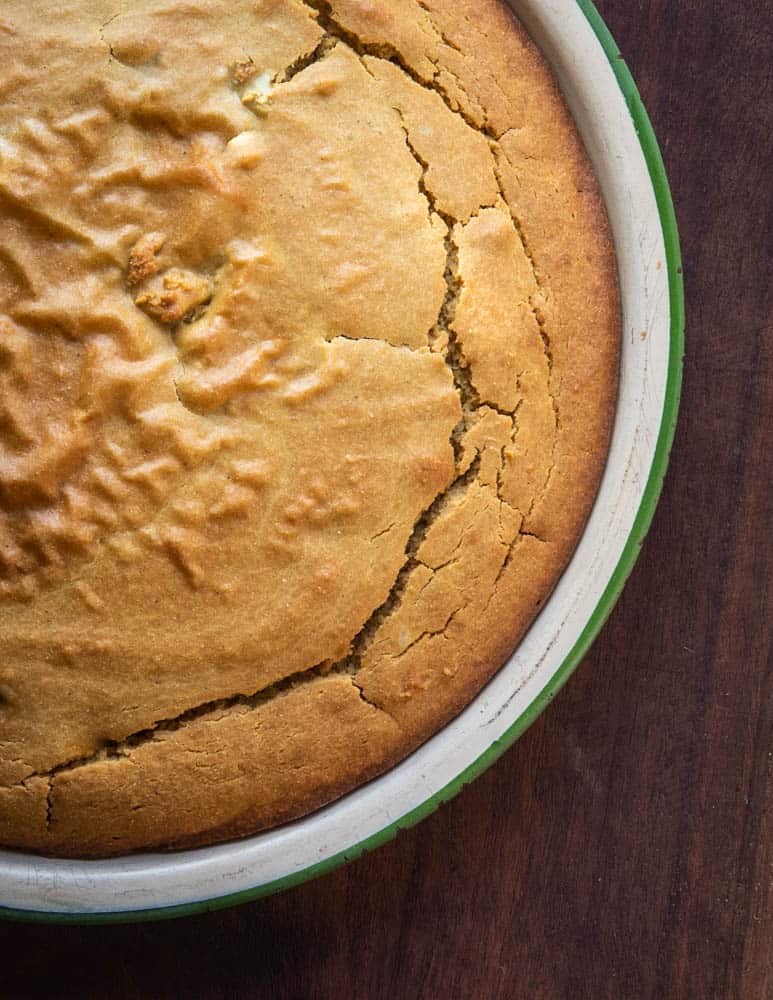
The pollen "fudgy" quality
Finished baked goods made with a proportion of pollen in the batter will take on a subtle yellow color, and depending on the preparation, a subtle granular (not in an unpleasant way) texture of the pollen.
What I like the most though, is the sort of dense, fudgy texture that pollen gives finished baked goods—something I didn't expect at all when I first started cooking with it. Like most things involving pollen, it's a delicate quality, but tasty and pleasant, nonetheless.
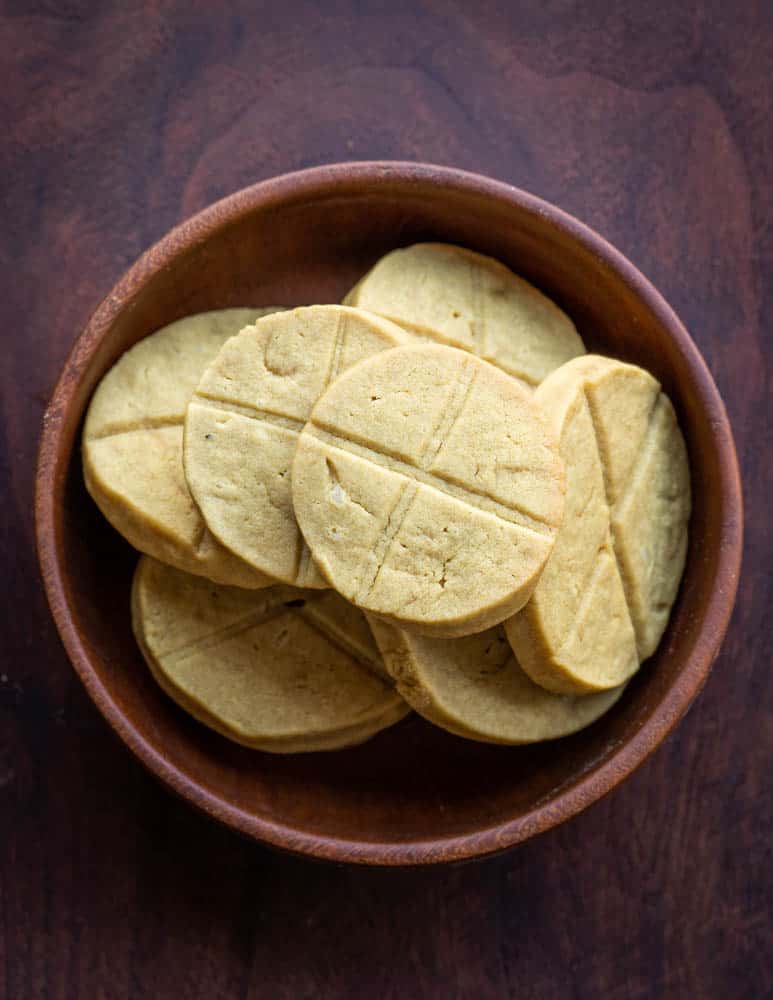
Flavor affinities
Pollen is a delicate flavor and aroma, so you don't want to pair it with other flavors that are aggressive. For example, cornbread flavored with honey and lemon zest is a good way to enjoy it, but putting some pollen in your jalapeno cheddar cornbread would be a waste.
Honey and lemon
Thinking of pollen as what it is (a product of flowers) is a good way to think about flavor partners and how to showcase it's flavor and texture. From my experience, two of the things pollen seems to pair the best with are honey and lemon, although it likes fats like butter and cream too.
Quick pasta sauce
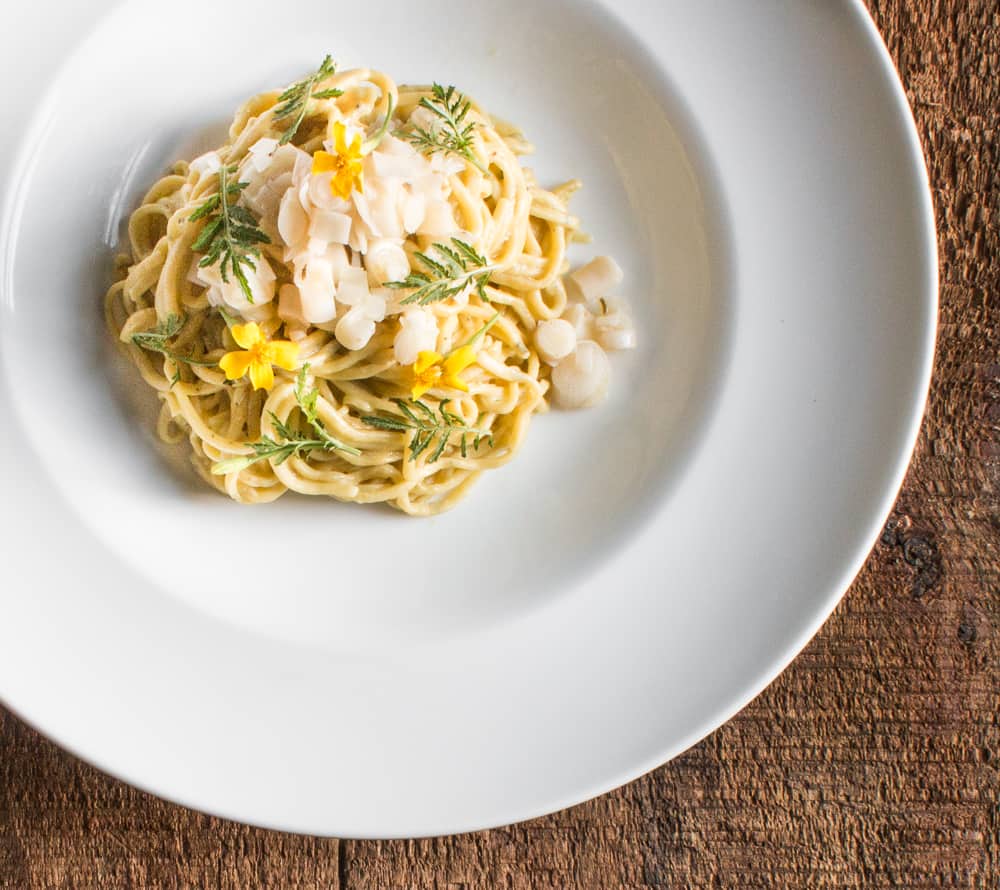
One of my favorite ways to use pollen in small amounts is as a simple pasta sauce, with nothing more than a little salt, stock, and, most importantly, fat. Pine pollen is dry, and doesn't taste like a lot by itself, (cattail pollen is a little more flavorful) but, once you add a little fat (typically butter) and a pinch of salt, it almost takes on a cheesy quality, and, when cooked with other ingredients from the same region or area, can be a good example of terroir-based cooking, and a way to be in touch with where you live.
Pollen Recipes
Pine Pollen Pancakes with Mugolio Pine Cone Syrup

Brian
Hi Alan, do you happen to know if spruce pollen is similarly usable? I’ve got more spruce than pine around me at the moment and they seem to produce a decent amount
Alan Bergo
Yes that will work fine. It's harder to gather in quantity, but it works.
John King
Hello Alan, you do not suggest using white pine, wondering why not? I have huge white pines and great pine production, John
Alan Bergo
Hey John. Red pine produces the most pollen and is the easiest to harvest. White pine doesn't produce as much, which means it's more work to get a comparable amount. Since pollen is labor intensive, I definitely recommend red over white. Both can be harvested, it's just a matter of how much work you're willing and able to put into it.
Megan
Hello,
Do you recommend any Florida pines for harvesting pollen? It seems we have quite a few here.
Alan Bergo
I don’t live in Florida, so here’s my advice. Find trees with the largest amount of male cones and harvest the pollen from them.
Amanda
Same advice for NJ pine trees?
Alan Bergo
Yes.
Ranger
Nice,
I have birch pollen. Gonna try do something with it.
Alan Bergo
Let me know how it works for you.
Sarah
Fantastic & exciting article.
The bit I need more info on will seem obvious....what does a pine flower look like, what falls off it into the bag. Some big close up photos would help me (as I'm on a phone). I've got a Scots Pine with what I think are flowers, with lumps of pale brown stuff. I have tried eating it - chewy, one was sweet. Seeing the dust, I'm assuming that these lumps are not the pollen! Thanks Sarah
Alan Bergo
Sarah It's hard for me to understand what's going on here. I'd need some pictures. Feel free to send them to me: alanbergo3 AT gmail.com
Stacy Taylor
You can tap birch for sap as well, the same as maple. The sap/syrup is like no other. Similar to maple but a bit more savory ❤️
Alan Bergo
I have a walkthrough of how I use birch syrup here.
Susan Virnala
We live in north Iowa and am wondering just how do you know its a male tree?!! Also does it matter what pine are we looking for? There's quite a bit of white pine and Norwegian pine around here. And what about cedar?
Alan Bergo
The easiest tree to harvest from will be Pinus resinosum-also known as Norway pine. Every tree will make pollen. I don't suggest trying to harvest from cedars or white pine.
dawn Stafford
Does the tree get new tips and then flower?
I have harvested pine tips and never have seen pollin!
Alan Bergo
I don't understand exactly what you're asking here, but yes, the pollen comes after the new tips grow. It's produced by the male cones.
Cosette
“It is important to note that pine pollen cannot be consumed straight from the tree!
Pine pollen cannot be digested by the human body raw. It must be prepared for consumption before any attempt is made to introduce it into a diet.“
Alan Bergo
Tell that to the Chinese who've been making candy with it raw for 1000 years.
Christine r Wagner
Exactly!
Ellyn
Hi Alan, I met your last Sept at the Barronett Foray in Wi, I stored my pine pollen from the spring in a mason jar in the frig and now it's no longer a powder, more like a sponge. It smells fine and there's no mold, it's just a solid. Do you think it's still good to use? Much appreciate your opinion. Thanks
Alan Bergo
Thanks Ellyn,
As I understand it, pollen needs to be frozen for long term storage as it can mold. As an aside, it wouldn't surprise me if dehydrating the pollen in a tray wouldn't extend the shelf life, though. As for your safety question, if it was me, and the pollen tasted pleasant, without any visible sign (color, texture, or anything else) of it being denatured or changed, I would probably use it and I doubt you would have an issue. I would probably use it in something that is cooked to function as a kill step, at least at first. But, I haven't consumed or handled pollen that old that hasn't been frozen, so I'm speculating. If you can find any follow-up info, anecdotal or otherwise let me know! Thanks.
Ellyn
Will do! Thanks for your advice.
Stefan
I harvested a a gallon bag of pollen a few years ago, intrigued by the medicinal values and I was quite put off by the many, many very tiny larvae I saw crawling around in it. How do you sift out these creatures?
Alan Bergo
As I mention in the post, humans aren't the only creatures attracted to pollen. I've never seen larvae in mine, just a few ants here and there at most. You'd want to sift them out. I use a tamis sieve.
Faeryll
Do you think combing pollen with honey would be a good method of longer term storage?
Alan Bergo
Possibly, but I don't really see the point. It's easy to store in a small bag or jar in the freezer.
Shaunn
I collect pine pollen from my own tree. Makes plenty for my needs. Only need a teaspoon for most recipes.
Remember, if handled carefully, pollen is alive. It's more potent if used raw, such as shaking in a vinaigrette at the last minute. At ,least this is what my guru told me. The rawer the better.
Also collect the pollen buds when green and tender. Toss in pasta dishes or salads. About a tablespoon per serving.
These can also be frozen. They thaw quickly.
I use plastic containers with no odor issues. Am just sure to use containers that didn't store strong-flavored foods; those WILL affect flavor! Use very small containers to reduce the problem of introducing air. Pack tight. My containers hold only 2 tablespoons each.
Store all containers in vacuumed bag. Revacuum after each removal. Easy to use small amount before it absorbs flavors.
Bentley
Was wondering about different stages as have a lot of underdeveloped red pine blown down in a wind storm. Found my chickens like them and now with this research they’ll be salad bound.
Alan Bergo
Hey Thanks Bentley. Now I have another thing I can feed to the chickens over here!
To br
Can pine pollen get spoiled/moldy?
Alan Bergo
Yes
Randall A. Little
Hey i want to know that what`s the uses of pine pollen ????? can i take pine pollen tablet or suppliments..
Alan Bergo
I don't discuss medicinal aspects of plants or mushrooms.
Philip Kent
Hi, can I take pine pollen supplement? like tablets or capsules? I found some here:
Alan Bergo
I can't speak to any medicinal uses of this product.
Philip Kent
Thanks Alan. I think I should check reviews before ordering. And also should consult with doctor first.